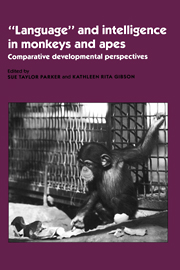Book contents
- Frontmatter
- Contents
- List of contributors
- Foreword
- Preface
- Acknowledgments
- Part I Theoretical frameworks for comparative developmental studies
- Part II Comparative developmental perspectives on cebus intelligence
- Part III Questions regarding imitation, “language,” and cultural transmission in apes and monkeys
- 9 Do monkeys ape?
- 10 Cultural transmission in the tool use and communicatory signaling of chimpanzees?
- 11 Primate cognition: From representation to language
- Part IV Developmental perspectives on social intelligence and communication in great apes
- Part V Development of numerical and classificatory abilities in chimpanzees and other vertebrates
- Part VI Comparative developmental perspectives on ape “language”
- Index
11 - Primate cognition: From representation to language
Published online by Cambridge University Press: 11 May 2010
- Frontmatter
- Contents
- List of contributors
- Foreword
- Preface
- Acknowledgments
- Part I Theoretical frameworks for comparative developmental studies
- Part II Comparative developmental perspectives on cebus intelligence
- Part III Questions regarding imitation, “language,” and cultural transmission in apes and monkeys
- 9 Do monkeys ape?
- 10 Cultural transmission in the tool use and communicatory signaling of chimpanzees?
- 11 Primate cognition: From representation to language
- Part IV Developmental perspectives on social intelligence and communication in great apes
- Part V Development of numerical and classificatory abilities in chimpanzees and other vertebrates
- Part VI Comparative developmental perspectives on ape “language”
- Index
Summary
After giving a brief definition of terms, I argue for the existence of basically similar ways of coding environmental stimuli in terms of cognitive organization throughout primate species, including humans. Some examples are given in order to show that numerous species express behaviors involving various forms of schematization or mental representations of parts or wholes of their environment.
I then examine communicative abilities in animals and in humans. Various characteristics of communicatory signals are discussed, namely, their disengagement from context and their intentionality, considered as possible criteria to assess their status as signs or symbols.
Next, I treat the question of language and debate the existence of linguistic competence in animals, particularly in primates. For that purpose, I present a critical review of the language studies in apes. A consideration of functional features of human language (more precisely, of the notion of “radical arbitrariness” of the verbal sign) is applied to the performances of languagetrained apes, with the aim of suggesting that these capacities do not qualify as truly linguistic.
In sum, I try to show that whereas most of the complex forms of cognitive activities of animals and humans can be viewed within a framework of biological continuity, language cannot be so interpreted. Rather, it is the result of simultaneous biological evolution and social evolution, which have led to a merging between communicational and representational systems.
Information
- Type
- Chapter
- Information
- 'Language' and Intelligence in Monkeys and ApesComparative Developmental Perspectives, pp. 312 - 330Publisher: Cambridge University PressPrint publication year: 1990
Accessibility standard: Unknown
Why this information is here
This section outlines the accessibility features of this content - including support for screen readers, full keyboard navigation and high-contrast display options. This may not be relevant for you.Accessibility Information
- 8
- Cited by
